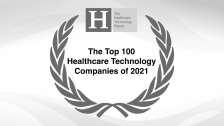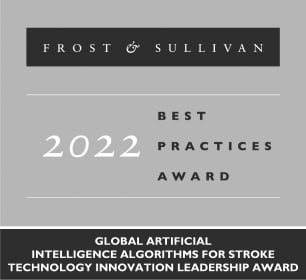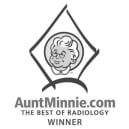[Insights in AI Virtual Series Webinar] Join us April 23 as Dr. Vishal Jani shares proven approaches to help improve outcomes for hemorrhagic stroke patients.
At RapidAI, we understand that technology is just one part of any successful patient outcome. From the person who picks up the phone to call 9-1-1, to the first responders, doctors and other healthcare professionals providing care, there are many heroes in each story. Here, we spotlight these incredible individuals who are saving and changing lives in our Rapid Hero Stories.
It had been hours since Dr. Raghid Kikano gave the order to transfer a stroke patient to the Lebanese American University Medical Center-Rizk Hospital in Beirut, and there was still no sign of when the ambulance would arrive. The satellite hospital where the patient had been admitted was no more than 15 minutes away by car in normal conditions, but this was January 2020. Only months earlier, the October Revolution had ignited a series of protests throughout Lebanon, and in the capital city of Beirut, continued civil unrest was still making road closures commonplace and travel times wildly unpredictable. With the window of treatment closing, Kikano, an interventional radiologist, was worried that the patient would be past the point for treatment.
The ambulance had been on the road for four and a half hours before arriving with the patient at LAU Medical Center at 4:30 pm. She was a 62-year-old woman with a history of atrial fibrillation who had stopped taking her blood-thinning medication about two weeks before her stroke. The woman had been found by her daughter in their home at around 10 am and was taken to the satellite hospital. There, a non-contrast CT (NCCT) scan revealed a dense MCA sign, indicating an occlusion of the middle cerebral artery, and prompted Kikano to order the patient transferred to the comprehensive stroke center for treatment. “These are typically the kinds of stroke that benefit enormously from mechanical thrombectomy and don't respond well to just drugs or blood thinners like tPA,” he explained.
At LAU Medical Center, the patient’s symptoms included aphasia and lower and upper extremity weakness on her left side. Her National Institutes of Health Stroke Scale (NIHSS) score was 22, signaling a severe stroke. Kikano ordered CT angiography and CT perfusion scans but acknowledged the possibility that too much time may have passed for a thrombectomy to be helpful. “After six and a half or seven hours, there is concern that more harm or damage can be done to the patient than good through intervention,” Kikano explained.
Fortunately, the hospital is equipped with RapidAI imaging technology, which uses artificial intelligence to create real-time views of brain perfusion from a patient’s scans. Within minutes, the software provided Kikano with a clear map of how the patient’s stroke was progressing. He was pleased to see that in this particular case, it was progressing slowly. The patient had a good system of collateral blood vessels that were helping to provide oxygen to the brain, and there was a large amount of tissue that could potentially be saved from infarction if the clot blocking blood flow through the main artery was removed.
Kikano began the procedure around 5:30 pm, and within half an hour, the clot had been removed and blood flow restored. Within two days, the patient’s NIHSS score had dropped to 2, and she was discharged from the hospital three days after having her stroke. Her recovery was so quick that she was able to attend her daughter’s wedding three week’s later. “I was really happy. She texted me on WhatsApp thanking us for allowing her to be at her daughter's wedding. It was really touching,” Kikano said.
RapidAI gives stroke teams and their patients more of what they desperately need: time. By notifying the entire stroke care team—doctors, emergency personnel and logistics—at the earliest possible moment and giving them the patient images and information they need to make the best possible decisions, they can save lives.
“The Rapid [platform] is our work horse. None of our patients come to the hospital without getting scans processed by Rapid. The software allows me to select the patients who would benefit from treatment from the patients unlikely to benefit from treatment, and by doing so, you increase the chances of success enormously. It’s like going from being able to help 3 patients out of 10 to helping 8 patients out of 10. I can't imagine working without it. It's like my best friend in some cases.”
Raghid Kikano, MD
Clinical Assistant Professor, Division of Interventional Neuroradiology
Program Director, Residency in Radiology
Acting Division Head, Interventional Neuroradiology
LAU Medical Center-Rizk Hospital and School of Medicine
When deciding how to treat a stroke patient, Dr. Raghid Kikano often remembers something a former mentor told him: If you know how to do it, it doesn't mean that you have to do it. “I never forgot that sentence,” said the interventional radiologist, and it’s something he applies to his practice at Lebanese American University Medical Center-Rizk Hospital. “When a patient has a big artery that is occluded, it doesn't mean that we have to [remove the clot] if the patient will not benefit from opening the artery. We might hurt them,” Kikano said.
To help identify patients suitable for thrombectomy, Kikano relies on the Rapid stroke imaging platform, which has been clinically proven to aid in the selection of patients for acute stroke therapy. “The software allows me to select the patients who would benefit from treatment from the patients unlikely to benefit from treatment, and by doing so, you increase the chances of success enormously.”
In a country like Lebanon where new techniques like thrombectomy are typically not covered by medical insurance, expense of the procedure also adds another reason to act with certainty. “It's an expensive procedure. The patient might end up paying $10,000 out of pocket,” said Kikano who often shares the color-coded RapidAI results with a patient’s family members as a way to explain whether intervention would be beneficial. “I always show them the RapidAI maps. … It really gives me the confidence to say definitively whether we can help the patient and answer specific questions.”


